NOTE: This post is a recap of XPLANE’s Start / Stop / Continue: Augment your Strategy with a Near-Term Resilience Plan webinar. If you’d like more information on this topic, we invite you to view it!
A little over a month ago, we all had a vision of where our companies were going and a strategy to get there.
In short order, the coronavirus pandemic made our plans obsolete.
In times like these, we as leaders must react quickly and provide clear guidance about where we’re going and how we’ll get there.
To accomplish this, we at XPLANE create what we call a resilience plan—a plan that bridges the gap between the immediate crisis and longer-term strategy.
Elements of a Resilience Plan
A resilience plan consists of three key elements:
- A set of scenarios about what might be ahead and actions to take in each case.
- A set of near-term priorities and decisions about what needs to be set aside.
- A way to manage prioritized initiatives until we arrive at a new normal.
Preparing for Resilience Planning
Before you build a resilience plan, you need to assess the current situation through a few lenses.
Lens #1: Outcomes of Change
First, you need to understand the new context and the four likely outcomes of the change organizations are now experiencing.
 Go faster. Healthcare organizations and companies that deliver remote work solutions must go faster. They are experiencing a massive surge of work, straining resources to the hilt.
Go faster. Healthcare organizations and companies that deliver remote work solutions must go faster. They are experiencing a massive surge of work, straining resources to the hilt.
 Tap the brakes. Many software and professional service firms whose workforces are already accustomed to working remotely need to “tap the brakes.” These organizations expect diminished revenues and need to conserve resources. Many organizations are in this category right now.
Tap the brakes. Many software and professional service firms whose workforces are already accustomed to working remotely need to “tap the brakes.” These organizations expect diminished revenues and need to conserve resources. Many organizations are in this category right now.
 Stop the car. Small businesses and many nonprofits must “stop the car” to make major shifts in strategy to ensure sustainability.
Stop the car. Small businesses and many nonprofits must “stop the car” to make major shifts in strategy to ensure sustainability.
 Break the glass. Many organizations and even entire industries such as travel, food services, and street retail are facing a “break the glass” moment, an existential crisis that will require major retooling for survival.
Break the glass. Many organizations and even entire industries such as travel, food services, and street retail are facing a “break the glass” moment, an existential crisis that will require major retooling for survival.
Depending on your industry and your individual circumstance, you will need to develop a different set of scenarios to help guide your response and lead your organization.
Lens #2: The Long View
How do you expect this crisis to play out and how can you prepare for each phase of change?
Typically, there are four phases on the route to full recovery.
Phase 1—Crisis. During the initial crisis, we see a growing sense of fear as daily life is disrupted. For many, the speed of this pandemic has been shocking. We have to respond much faster than people feel prepared to do.
Phase 2—Recession. In this phase, we must plan for the realities of recession. We’re already experiencing some severe revenue declines. During this time, company cultures are deeply impacted by the decisions we make and how we make them.
Organizations need to examine their values, make hard decisions, reprioritize, and plan contingencies to weather the storm. This is where most organizations are today. We don’t know how long the crisis will last, so we need to build various scenarios based on available data and best guesses.
Phase 3—New normal. At this point, the situation stabilizes. We’re already seeing a new normal in certain aspects for some of us around the globe.
At this point, we’ll have adjusted our organizational structures to match the new market reality of supply and demand. Most of us will have stabilized our liquidity and our teams will have adjusted to new ways of working and new operational norms.
At this point, we can start to shift from a resilience plan to a longer-term strategy once more.
Phase 4—Recovery. Here, we’ll move into recovery, although in a new reality and a redefined context. Longer-term strategic plans will be relevant once more.
At this point, we will need to examine our strategies through the lens of our new context. How has the new normal shifted or changed our new business reality? How do we have to adapt our strategy to fit this?
Organizations that build their near-term resilience plan with the long view in mind are likely to make much better decisions in the weeks ahead. They will plan for sustainability today but preserve resources for faster recovery tomorrow.
Lens #3: Implications
As we respond to the crisis, we must keep a few things in mind:
- “Wait and see” won’t work. This pandemic is different than anything we’ve seen before. It’s fast, it’s global. We need to respond. We cannot simply wait for it to blow over.
- Plan faster. The situation is incredibly fluid. We need a plan that is more aggressive than our stakeholders are likely able to imagine.
- Recovery could be slower. This crisis is a structural event. Many businesses could disappear and entire industries are likely to be reshaped.
- The new normal might not be like anything we’ve known before. We are being thrust into new realities. We have entered the world of remote work, probably for good. We may need to rethink how we use travel in our lives. Social distancing may occur again in our future.
It’s important to keep in mind that the new normal is not all negative. Opportunities will be created. We’ll see new ways of working, new technologies, and increased connection on a global scale.
Creating a Resilience Plan
How do we take practical steps to create a resilience plan for our organizations?
The Basics
First, remember that you do not need to throw away your strategy—you just need to change your route in the near term.
Second, determine your immediate needs to manage your organization through this crisis, and look for opportunities to accelerate your path to recovery tomorrow.
The Elements
At XPLANE, we build resilience plans through workshops consisting of exercises that help you and your team(s) identify scenarios, prioritize activities, and take action.
Here’s an overview.
The Agenda
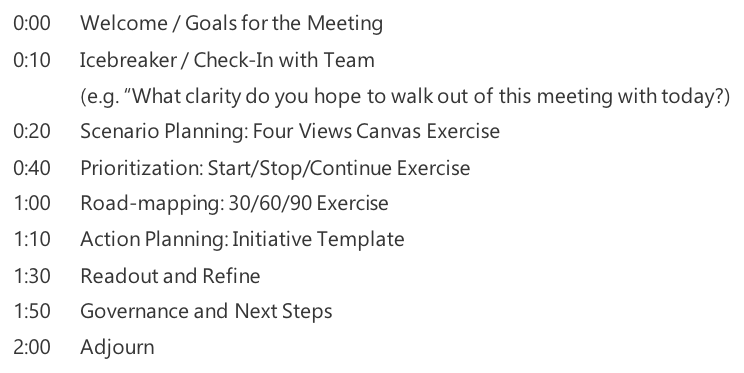
At XPLANE, our above sample agenda is designed for a two-hour workshop, broken into 20-minute modules that can be adjusted up or down as needed.
Each module consists of a discrete, collaborative exercise with a clear purpose. Because all voices need to be heard, we recommend you use the first 20 minutes of your workshop to set this expectation.
Resilience planning requires broad representation and buy-in, so we recommend that attendees represent key functions within your organization.
Scenario Planning
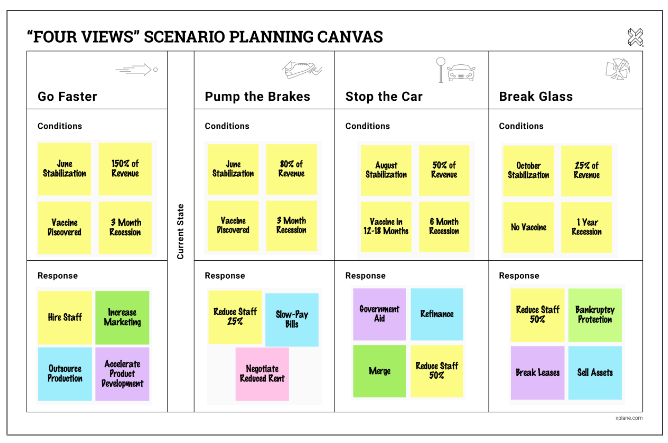 In this module, we use our Four Views Canvas to quickly put together scenarios and accompanying responses for your business.
In this module, we use our Four Views Canvas to quickly put together scenarios and accompanying responses for your business.
This exercise helps your team see the long view and accelerates decision making. It gets you thinking proactively, anticipating possible situations and pre-thinking possible responses to each.
Start, Stop, Continue Exercise
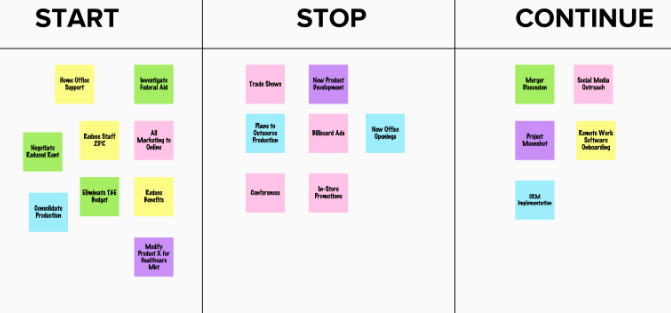 XPLANE’s Start, Stop, Continue Exercise helps your team understand both what you need to do and what you need to stop doing to move forward.
XPLANE’s Start, Stop, Continue Exercise helps your team understand both what you need to do and what you need to stop doing to move forward.
Remember that stop doesn’t necessarily mean forever.
A good rule of thumb is to put as many activities in the stop bucket as you have in the start bucket.
Prioritization
Prioritization is essential because crises require us to ruthlessly triage our activities. For everything that we add to our plates, something must come off.
In this module, you’ll discuss how to prioritize your ideas, select the plan that makes sense, and document your collective action plan for each. You’ll be able to update and maintain your plans as new information comes in.
Road Mapping
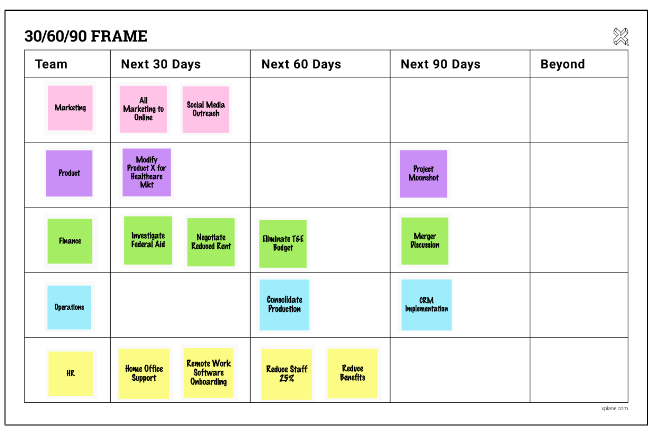 Next comes road mapping, in which you assemble identified priorities into a picture that shows the order in which you’ll attack activities.
Next comes road mapping, in which you assemble identified priorities into a picture that shows the order in which you’ll attack activities.
In this step, you identify what you need to do in the near term. While most of us are accustomed to planning in quarters or years, that’s not our current reality. We’re looking at 30, 60, or 90 days out.
You can then refine your road map by asking three questions: (1) Are the due dates realistic? (2) What dependencies exist between each of these elements and how might that adjust the scheduling? (3) What’s missing?
Action Planning
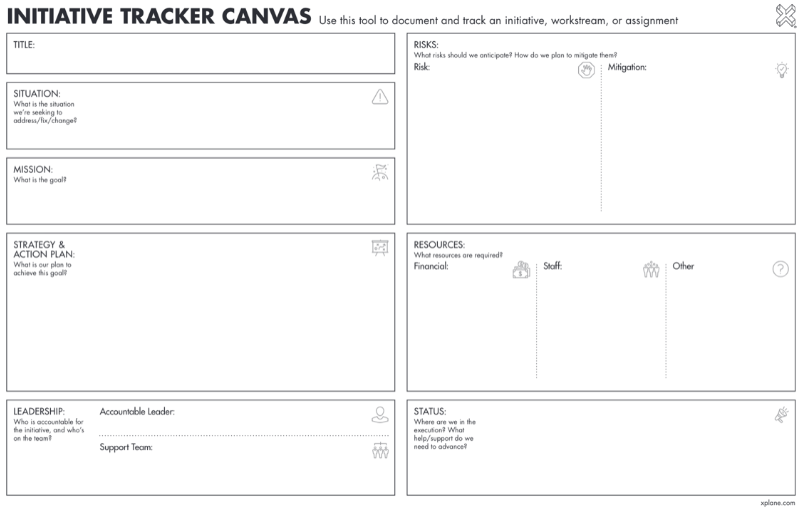 You now have a draft roadmap to carry forward into action planning.
You now have a draft roadmap to carry forward into action planning.
While some of your activities may be existing initiatives that are already assigned, many of these activities are going to be new. You’ll need to add detail, build these into your action plan, and assign each activity to an individual or team.
XPLANE uses our Initiative Tracker Canvas to assign and track work on an ongoing basis. It’s a simple but powerful canvas that can be managed digitally or displayed in an office to show and track progress on initiatives in one place.
Be Ready for Change
Your resilience plan will help your organization better move through crisis into recovery.
By making difficult decisions today and keeping an eye toward the future, you will know what to protect in terms of people, resources, capabilities, and culture to rise again with strength tomorrow.
To learn more on this topic, we invite you to view our Start / Stop / Continue: Augment your Strategy with a Near-Term Resilience Plan webinar.
And as always, if you have any questions or comments, please reach out to us.
____________
For more information on strategy planning and implementation, we recommend these XPLANE blog posts:
